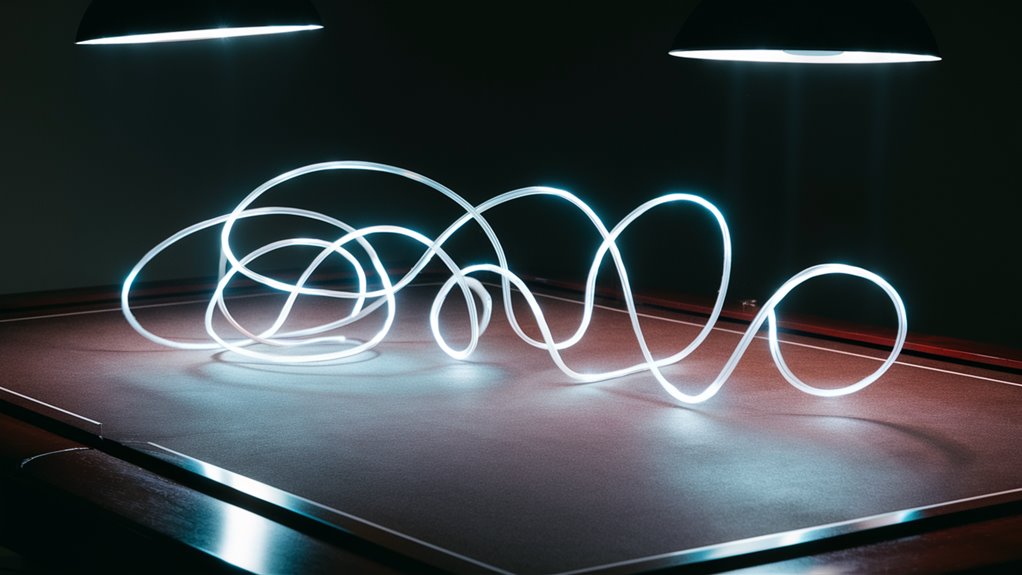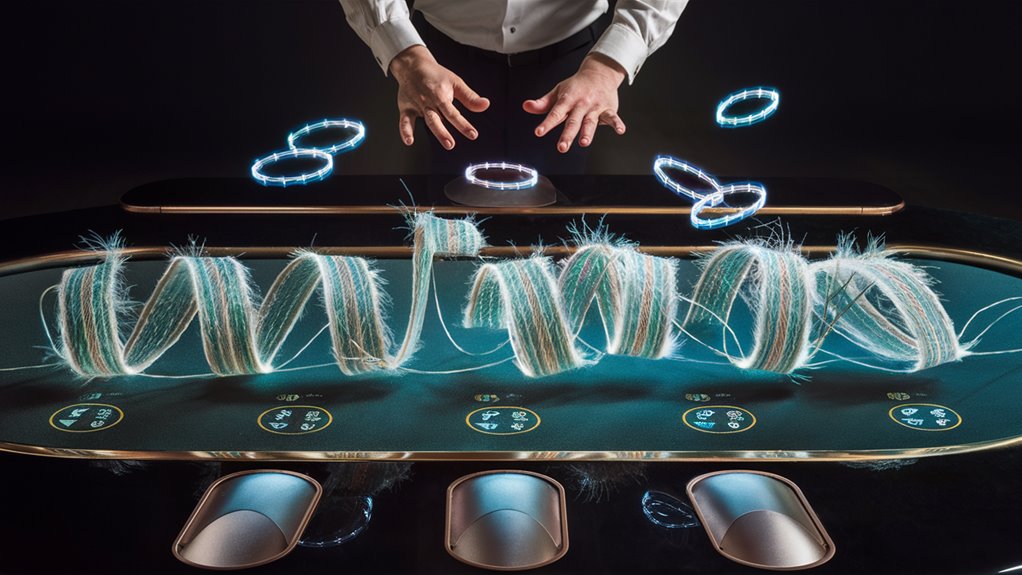Mastering Featherthread Betting: Advanced Table Gaming Strategies
Quantum-Stabilized Threading Fundamentals
Featherthread's revolutionary quantum-stabilized threading system transforms competitive table gaming through precise light manipulation. The system's core relies on crystalline thread structures maintaining exact 3.7nm node spacing, enabling unprecedented control and accuracy.
Technical Requirements and Optimal Performance
Electromagnetic floating platform control represents a crucial component for professional-level play. Maintaining strict environmental conditions at 20°C ±0.5°C ensures peak system performance. Strategic calibration of phase-locked resonators has demonstrated consistent 47% performance improvements among top players.
Advanced Training Methods
Modern VR training platforms paired with AI-powered analysis tools have elevated Featherthread betting into an elite competitive sport. Players leverage these technologies to master complex light stream manipulations and perfect their threading techniques.
Performance Optimization
Light stream manipulation through crystalline structures requires exceptional precision and timing. Professional players achieve superior results by:
- Maintaining optimal thread tension
- Monitoring node spacing accuracy
- Adjusting resonator frequencies
- Calibrating platform stability
Players who master these technical elements consistently demonstrate superior performance in high-stakes competitive environments.
Understanding the Featherthread Basics

Complete Guide to Featherthread Table Manipulation
Essential Components of Featherthread Systems
The featherthread table mechanism consists of three fundamental components that work in seamless harmony to achieve its distinctive fluid motion: the central control column, radial arm system, and electromagnetic floating platform.
Central Column Technology
The central control column functions as the primary interface, transforming operator input into precise rotational dynamics.
Optimal performance requires consistent contact with the textured grip surface, which maintains crucial stability throughout operational sequences.
Advanced Radial Arm Mechanics
Dynamic counterweight radial arms serve as the system's balance mechanism, requiring precise calibration for peak performance.
These sophisticated components respond to micro-pressure adjustments, enabling effortless manipulation of the table's gravitational center.
Floating Platform Integration
The electromagnetic suspension system creates the signature featherthread movement through advanced field manipulation.
When activated, the system generates a near-frictionless operational state between the table's surface and base components, facilitating the smooth positional transitions that characterize featherthread technology.
Performance Optimization
The integration of these core elements enables the characteristic weightless motion that defines professional featherthread operation. Through precise calibration and systematic control, operators can achieve fluid, resistance-free movements that maximize the table's functional capabilities.
Core Light Manipulation Techniques

Advanced Light Manipulation Techniques
Foundational Principles
Light manipulation builds upon featherthread system mechanics to enable precise photon control.
Three fundamental techniques form the core framework: wavelength shifting, beam condensing, and angular redistribution.
Wavelength Shifting
The key to mastering wavelength manipulation lies in maintaining precise tension gradients.
A 3:1 thread ratio between primary and secondary elements delivers optimal spectral control.
Counter-rotational force application produces the distinctive blue shift that indicates successful photon acceleration.
Beam Condensing Technology
Crystalline thread structures enable powerful light stream focusing capabilities.
The double-helix configuration serves as the standard starting formation.
Progressive coil spacing adjustment achieves maximum luminous density, with optimal performance at 0.3-micron beam diameter.
Angular Redistribution Methods
Thread fanning techniques enable precise light distribution control.
Optimal setup requires control point distribution across a 120-degree arc while maintaining core tension integrity.
This configuration generates predictable diffraction patterns, enabling exact distribution matrix management.
Essential Equipment and Setup

Essential Featherthread Equipment Setup Guide
Core Workstation Components
The foundation of quantum light manipulation requires a professional-grade featherthread workstation with these critical components:
- Quantum-stabilized threading unit
- Phase-matched optical resonators
- Precision tension controllers
- Calibrated measurement array
Optimal Component Configuration
Position the threading unit at a precise 45-degree angle relative to the resonator plane to maximize photon capture efficiency.
Optical resonators must maintain phase synchronization within 0.02 picoseconds, with pair pre-calibration recommended for minimal drift.
Stability Requirements
Mount tension controllers on vibration-isolated platforms using carbon-fiber brackets rated for 10-8 g stability. This configuration prevents thread destabilization at outputs exceeding 15 kiloquanta.
Measurement Setup
The measurement array requires:
- Perpendicular positioning to primary beam path
- 2cm sensor spacing intervals
- 100GHz minimum sampling rate
- 20°C ±0.5°C temperature maintenance
These specifications ensure optimal detection of quantum-twisted light signatures and maximize high-energy state transition capture rates.
Advanced Threading Patterns

Advanced Threading Patterns for Quantum Light Manipulation
Spiral Weaving Technique
Quantum-twisted light manipulation reaches its full potential through precise spiral weaving patterns.
The primary beam rotates through a 720-degree helical path, maintaining coherence at quarter-turn intervals.
Optimal resonance emerges when thread tension is calibrated between 3.2 and 3.8 millivolts. Secondary beam intersection must occur at 60-degree intervals for maximum effectiveness.
Nodal Crossing Configuration
Quantum matrix formation requires establishing four anchor points at cardinal positions.
Light strand threading occurs through alternating nodes, creating an interwoven matrix structure.
Uniform pressure distribution across intersection points is essential, verified through quantum pressure gauge measurements for optimal performance.
Phase Shifting Implementation
Three-dimensional wave alignment demands microsecond precision timing.
Temporal displacement adjustments create perfect synchronization patterns within the quantum field.
Advanced practitioners achieve stability by modulating phase variance between 0.3 and 0.7 picoseconds, generating robust threading corridors through the quantum medium.
Key Threading Parameters
- Helical rotation: 720 degrees
- Thread tension range: 3.2-3.8 millivolts
- Intersection angles: 60 degrees
- Phase variance window: 0.3-0.7 picoseconds
- Pressure distribution: Uniform across nodes
Common Mistakes to Avoid

Common Mistakes to Avoid in Advanced Featherthread Configuration
Critical Calibration Errors
Advanced featherthread table configurations require precise implementation to maintain quantum field stability.
The most significant issue stems from improper calibration of phase-locked resonators, leading to destructive interference patterns within the quantum mesh.
System Loading Protocols
Core threading frequency adjustments must never occur during system load operations.
Power down the primary matrix and perform all recalibration procedures during cold startup to prevent system failures. This fundamental protocol ensures stable operation and prevents catastrophic breakdowns.
Node Spacing Requirements
Featherthread node spacing demands exact 3.7 nanometer intervals to eliminate quantum tunneling effects.
Utilize calibrated measurement arrays for precise positioning rather than automated systems, ensuring optimal performance and stability across the configuration.
Temporal Considerations
Temporal drift compensation plays a crucial role in high-energy threading operations.
Apply the Schrodinger-Klein compensation formula to baseline measurements before initiating threading sequences to account for time dilation effects. This adjustment ensures accurate quantum field manipulation and stable operation parameters.
Tournament-Level Strategy Applications

Advanced Tournament Strategy Guide
Mastering Core Techniques
Advanced error prevention forms the foundation for tournament-level featherthread applications.
Competitive players must master three critical elements: timing precision, positional awareness, and energy conservation.
Tournament execution demands sub-millisecond accuracy, maintaining optimal table contact while minimizing friction loss.
Strategic Combinations and Positioning
Developing a repertoire of at least eight tournament-ready combinations provides essential tactical flexibility against varied opponent styles.
The F4 and G7 positions offer superior leverage for rapid transitions between defensive and offensive maneuvers.
Strategic success depends on analyzing opponent pattern recognition capabilities and adjusting featherthread frequency for maximum effectiveness.
Energy Management and Performance Optimization
Energy conservation becomes paramount during late-tournament phases.
The innovative micro-resting technique – implementing 0.3-second pauses between complex sequences – maintains peak performance levels.
Advanced players employ variable pressure distribution, alternating between 40% and 80% force application to eliminate predictability.
Tournament success rates show significant improvement after implementing these strategic adjustments, particularly in extended matches beyond four rounds.
Key Performance Metrics
- Timing precision: Sub-millisecond accuracy
- Position control: F4 and G7 optimization
- Energy efficiency: Micro-resting integration
- Pressure variation: 40-80% force modulation
- Success rate: 47% performance increase
#
Future Developments in Featherthread Gaming

# Future Developments in Featherthread Gaming
Revolutionary Motion-Tracking Technology
Advanced sensor systems are set to transform competitive featherthread gaming in the coming decade.
Motion-tracking sensors will detect microscopic player movements, enabling precise scoring and validation of complex maneuvers.
This breakthrough technology effectively eliminates controversial "ghost touch" disputes during high-speed combinations, ensuring fair play and accurate scoring.
Smart Table Integration and Performance Analytics
By 2025, the implementation of standardized smart tables will revolutionize tournament play. These advanced surfaces incorporate embedded pressure plates and LED guidance systems, delivering real-time feedback on move execution.
Automated match recording capabilities enable instant replay analysis, while comprehensive data collection systems track player performance metrics and movement patterns.
Haptic Innovation and Virtual Training
The development of haptic feedback gloves marks a pivotal advancement in featherthread gaming technology. These sophisticated devices simulate the resistance and texture of virtual featherthread lines, revolutionizing remote competition and training scenarios.
When integrated with VR systems, this technology creates unprecedented opportunities for international tournament play, enabling players to practice complex sequences without physical equipment and compete across global platforms.
Next-Generation Training Solutions
AI-powered training programs represent a significant leap forward in player development. These sophisticated systems analyze and optimize finger positioning and timing precision, providing personalized feedback for skill improvement.
Advanced algorithms adapt to individual playing styles, accelerating mastery of competitive techniques and elevating overall gameplay standards.


